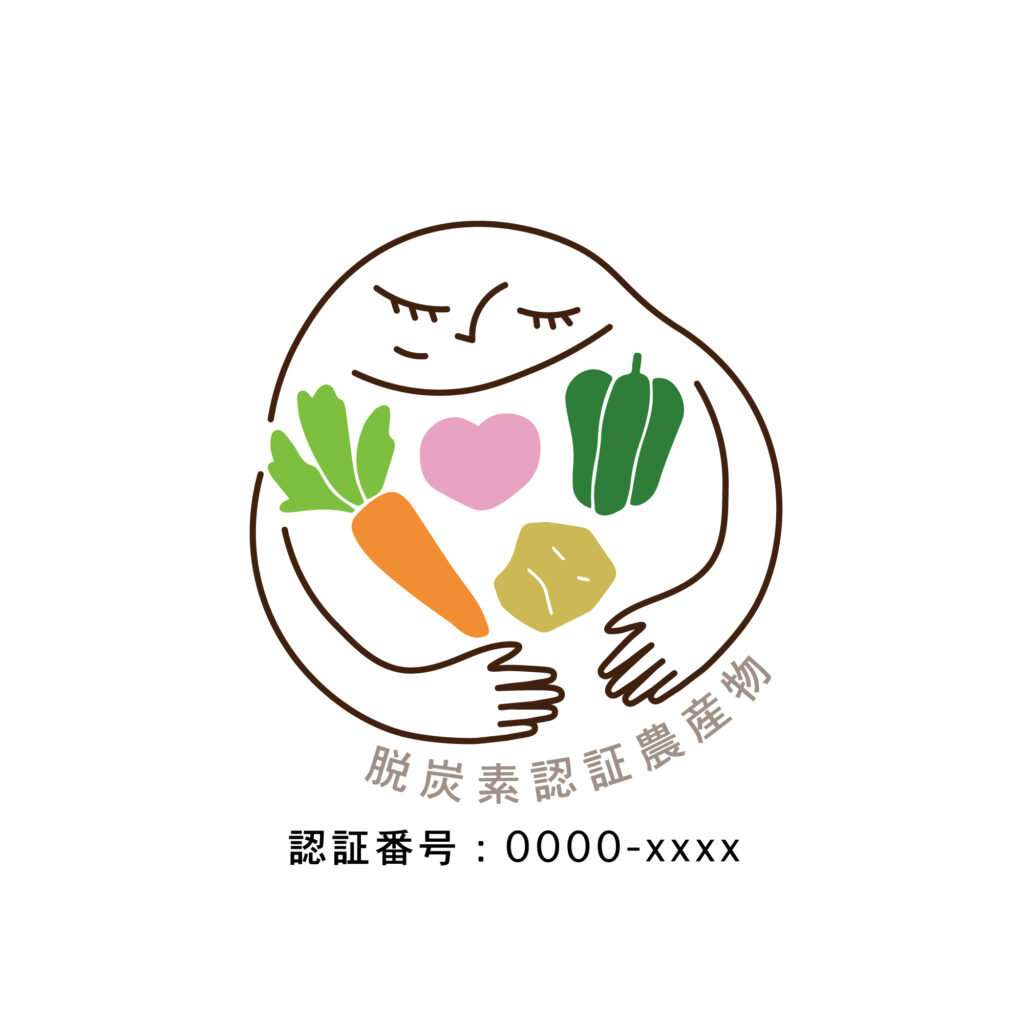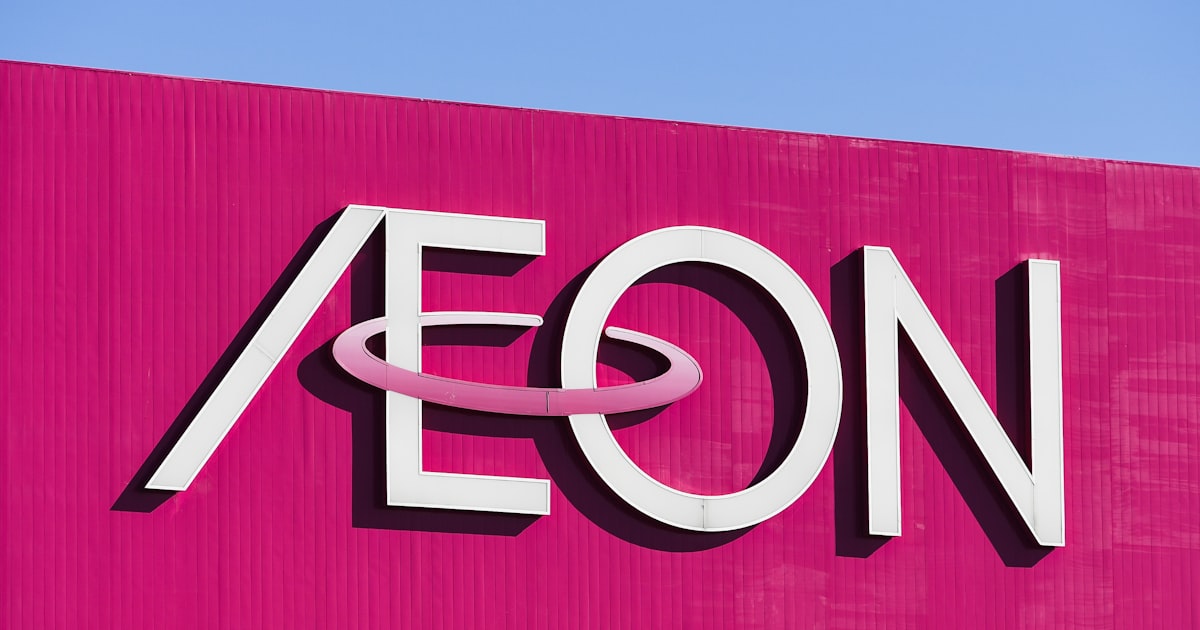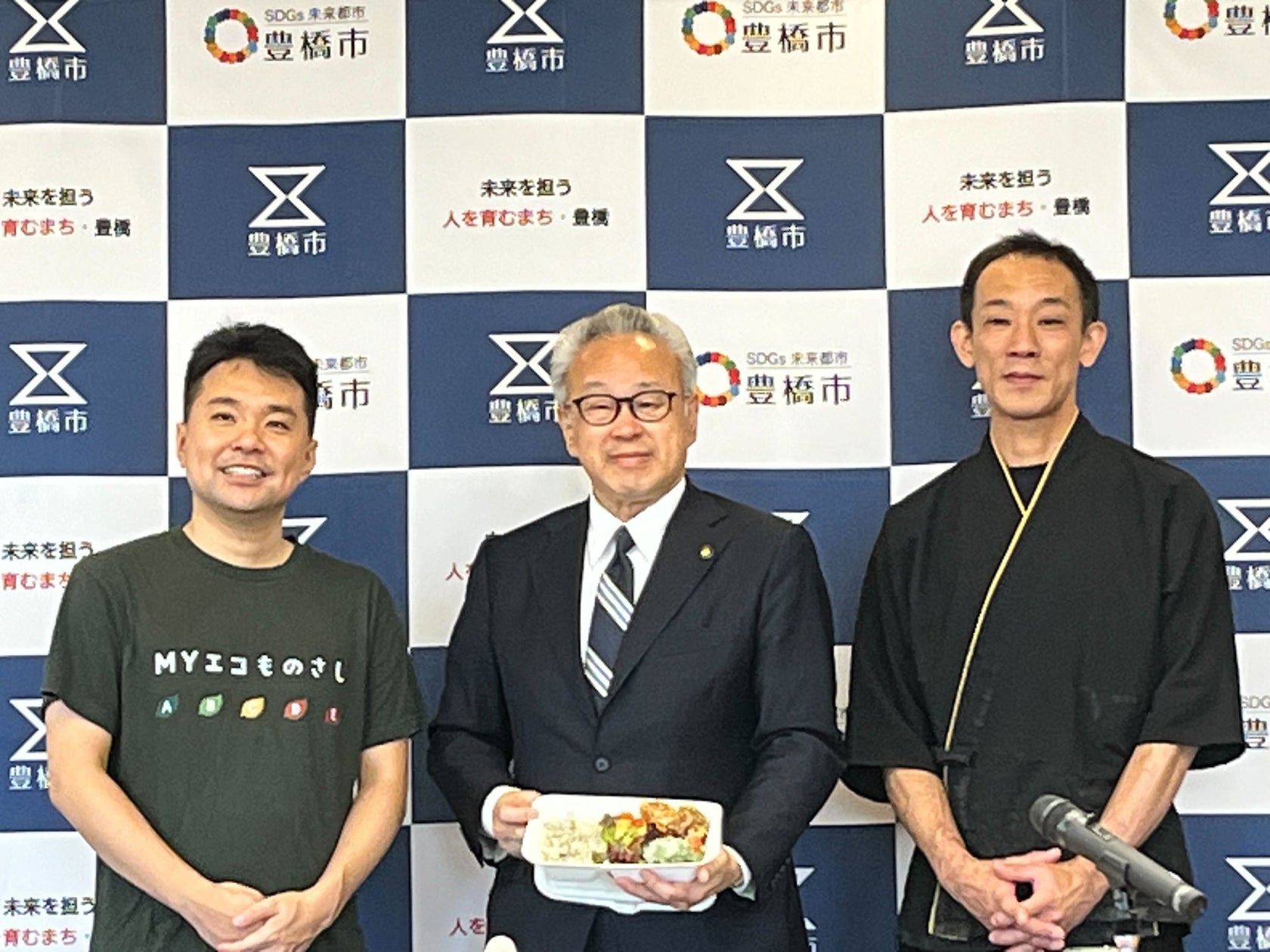The Intentions Behind It
Since the Green Revolution, achieving the core mission of Japanese agriculture and agricultural science, the “fight against hunger,” requires efforts to promote decarbonized agrifoods. These efforts are essential for ensuring a stable food supply while preserving the agricultural environment for crop growth.

Vision
Innovation: Creating innovative agricultural models by constantly incorporating new technologies and ideas without being confined to existing frameworks.
Co-Creation: Building the future together by collaborating with various stakeholders, including producers, consumers, and research institutions.
Transparency: Conducting highly transparent activities through a scientific approach based on data.
Mission
To overcome hunger and tackle climate change, striving for the happiness of all crew members aboard “Spaceship Earth.”
Value
Establishing a global standard for decarbonized agriculture to contribute to solving the world’s food challenges.
Expanding Japan’s decarbonized agriculture model globally to contribute to the realization of a sustainable society.
The global population is nearing 10 billion. With only 30% of the Earth’s surface as land, agriculture plays a crucial role in supplying food to these people. However, this food supply is under threat due to challenges such as global warming, rapid urbanization driven by population growth, and the increase in areas unsuitable for cultivation caused by overdevelopment and land misuse.
How much farmland can Japan leave for the next generation?
CPDA is an organization that considers climate change together with everyone and takes action starting with what is possible.
The Intentions Behind It
Since the Green Revolution, achieving the core mission of Japanese agriculture and agricultural science, the “fight against hunger,” requires efforts to promote decarbonized agrifoods. These efforts are essential for ensuring a stable food supply while preserving the agricultural environment for crop growth.

Vision
Innovation: Creating innovative agricultural models by constantly incorporating new technologies and ideas without being confined to existing frameworks.
Co-Creation: Building the future together by collaborating with various stakeholders, including producers, consumers, and research institutions.
Transparency: Conducting highly transparent activities through a scientific approach based on data.
Mission
To overcome hunger and tackle climate change, striving for the happiness of all crew members aboard “Spaceship Earth.”
Value
Establishing a global standard for decarbonized agriculture to contribute to solving the world’s food challenges.
Expanding Japan’s decarbonized agriculture model globally to contribute to the realization of a sustainable society.
The global population is nearing 10 billion. With only 30% of the Earth’s surface as land, agriculture plays a crucial role in supplying food to these people. However, this food supply is under threat due to challenges such as global warming, rapid urbanization driven by population growth, and the increase in areas unsuitable for cultivation caused by overdevelopment and land misuse.
How much farmland can Japan leave for the next generation?
CPDA is an organization that considers climate change together with everyone and takes action starting with what is possible.
What’s New
What’s New
What are Decarbonized Agrifoods?
Decarbonized Agrifoods are agricultural products produced through farming practices aimed at reducing or nearly eliminating greenhouse gas (GHG) emissions during the production process.
- Utilization of Renewable Energy
By employing renewable energy sources such as solar power and biomass power generation for agricultural energy needs, crops are produced using sustainable energy without reliance on fossil fuels. - Promotion of Organic Farming
By reducing the use of chemical fertilizers and pesticides and adopting organic fertilizers and environmentally friendly farming methods, the burden on soil and the environment is minimized, while CO₂ emissions are reduced. - Utilization of Carbon Sequestration Technology
By employing technologies that store carbon in agricultural soil, CO₂ levels in the atmosphere are reduced, enabling environmentally friendly farming practices. - Introduction of Energy-Saving Technologies
By adopting energy-efficient equipment and machinery, energy consumption is minimized while maintaining efficient agricultural practices. - Directly Linked to Reducing Farm Costs
The most important step is not to start with major equipment changes or drastic alterations to cultivation methods but to begin with actions that can be implemented in current production activities.
Examples:
1.Regular replacement of tractor coolant and oil
2.Cleaning soil from attachments
3.Routine cleaning of air conditioner filters in storage facilities
What are Decarbonized Agrifoods?
Decarbonized Agrifoods are agricultural products produced through farming practices aimed at reducing or nearly eliminating greenhouse gas (GHG) emissions during the production process.
- Utilization of Renewable Energy
By employing renewable energy sources such as solar power and biomass power generation for agricultural energy needs, crops are produced using sustainable energy without reliance on fossil fuels. - Promotion of Organic Farming
By reducing the use of chemical fertilizers and pesticides and adopting organic fertilizers and environmentally friendly farming methods, the burden on soil and the environment is minimized, while CO₂ emissions are reduced. - Utilization of Carbon Sequestration Technology
By employing technologies that store carbon in agricultural soil, CO₂ levels in the atmosphere are reduced, enabling environmentally friendly farming practices. - Introduction of Energy-Saving Technologies
By adopting energy-efficient equipment and machinery, energy consumption is minimized while maintaining efficient agricultural practices. - Directly Linked to Reducing Farm Costs
The most important step is not to start with major equipment changes or drastic alterations to cultivation methods but to begin with actions that can be implemented in current production activities.
Examples:
1.Regular replacement of tractor coolant and oil
2.Cleaning soil from attachments
3.Routine cleaning of air conditioner filters in storage facilities


In agriculture, forestry, and fisheries, greenhouse gases are emitted in situations like those shown in the figure above.
Reducing emissions in all these areas is essential.


The appearance of store displays featuring decarbonized agrifoods.
Agricultural products produced by acquiring knowledge about greenhouse gas emissions from one’s own farming activities and calculating the emission levels.
Agricultural products produced by acquiring knowledge about greenhouse gas emissions from one’s own farming activities and calculating the emission levels.
Agricultural products that achieve net zero emissions by the target year in accordance with a reduction plan and go further to achieve carbon negativity.
Agricultural products produced by acquiring knowledge about greenhouse gas emissions from one’s own farming activities and calculating the emission levels.
Agricultural products produced by acquiring knowledge about greenhouse gas emissions from one’s own farming activities and calculating the emission levels.
Agricultural products that achieve net zero emissions by the target year in accordance with a reduction plan and go further to achieve carbon negativity.


The Ministry of Agriculture, Forestry and Fisheries has launched initiatives aimed at achieving zero CO₂ emissions in agriculture, forestry, and fisheries by 2050.
Global warming has a significant impact on the stable harvest and quality of crops.
CPDA promotes decarbonization efforts to ensure a sustainable food supply.


MAFF
“Mieru Label” Introduction Page
Efforts in Japan


4 per 1000 Initiative
An international organization based in Montpellier, France.
Efforts of the 4 per 1000 Initiative


United Nations Initiatives
International Initiatives
What’s the Decarbonized Agrifoods Certification System?
1
Knowledge Acquisition
Quantification of Emissions
Acquire Basic Knowledge of Greenhouse Gas Emissions in Production.
Gain a fundamental understanding of greenhouse gas (GHG) emissions related to production and quantify your own emissions.
Calculation Certification Based on the GHG Protocol
Industry First
2
Formulation of Emission Reduction Plans
Develop a reduction plan based on the quantified emissions, with a standard timeframe of seven years.
This must be completed within 500 days of obtaining STEP 1, and the percentage of reduction achievements must be disclosed publicly.
3
Achievement of Reduction Targets
Creating new opportunities for market expansion.
Implement the PDCA cycle based on the reduction plan to achieve decarbonization by the target year.
What’s the Decarbonized Agrifoods Certification System?
1
Knowledge Acquisition
Quantification of Emissions
Acquire Basic Knowledge of Greenhouse Gas Emissions in Production.
Gain a fundamental understanding of greenhouse gas (GHG) emissions related to production and quantify your own emissions.
Calculation Certification Based on the GHG Protocol
Industry First
2
Formulation of Emission Reduction Plans
Develop a reduction plan based on the quantified emissions, with a standard timeframe of seven years.
This must be completed within 500 days of obtaining STEP 1, and the percentage of reduction achievements must be disclosed publicly.
3
Achievement of Reduction TargetsCreating new opportunities for market expansion.
Implement the PDCA cycle based on the reduction plan to achieve decarbonization by the target year.
What’s the Decarbonized Agrifoods Certification System?
Point 1
Acquiring knowledge about decarbonized agrifoods.
Quantifying CO₂ emissions.
Quantifying emissions can be challengi…
The calculation and reporting of greenhouse gas emissions follow an international standard known as the GHG Protocol.
Emission calculations based on this standard are extremely difficult for the average person to perform.
Here’s the solution we’ve prepared!
CPDA offers free support to members for completing the “visualization” simple calculation sheet provided by the Ministry of Agriculture,
Forestry and Fisheries (MAFF) and for submitting certification applications.
We assist with the quantification and certification of all agricultural products, including the 23 items selected by MAFF.
For quantification, we will introduce companies that perform calculations in compliance with the GHG Protocol.
Note: Even if MAFF expands the list of eligible items, we will continue to offer free support for the simple calculation sheet input and certification application process.
Once the emissions calculation is completed, the product will be certified as STEP 1 of the “Decarbonized Agrifoods Certification.”
Point 1
Acquiring knowledge about decarbonized agrifoods.
Quantifying CO₂ emissions.
Quantifying emissions can be challenging…
The calculation and reporting of greenhouse gas emissions follow an international standard known as the GHG Protocol.
Emission calculations based on this standard are extremely difficult for the average person to perform.
Here’s the solution we’ve prepared!
CPDA offers free support to members for completing the “visualization” simple calculation sheet provided by the Ministry of Agriculture, Forestry and Fisheries (MAFF) and for submitting certification applications.
We assist with the quantification and certification of all agricultural products, including the 23 items selected by MAFF.
For quantification, we will introduce companies that perform calculations in compliance with the GHG Protocol.
Note: Even if MAFF expands the list of eligible items, we will continue to offer free support for the simple calculation sheet input and certification application process.
Once the emissions calculation is completed, the product will be certified as STEP 1 of the “Decarbonized Agrifoods Certification.”
What’s the Decarbonized Agrifoods Certification System?
Point2
Formulation of an emission reduction plan.
Developing a reduction plan is even more challenging…
Hiring emission reduction consultants can cost several million yen for small and medium-sized enterprises, and for large corporations, the expenses can exceed 100 million yen to develop a reduction plan.
Financially, it can be said that it is difficult for individual producers as well.
Here’s the solution we’ve prepared!
CPDA collaborates with Green AI Co., Ltd. to develop decarbonization strategies tailored for agriculture.
We propose reduction measures that can be implemented without significant capital investment.
Additionally, if past and current emissions data are available, we calculate the percentage of emissions reduction achieved.
Through these reduction efforts, certification as STEP 2 in the “Decarbonized Agrifoods Certification” process will be granted.
Point2
Formulation of an emission reduction plan.
Developing a reduction plan is even more challenging…
Hiring emission reduction consultants can cost several million yen for small and medium-sized enterprises, and for large corporations, the expenses can exceed 100 million yen to develop a reduction plan.
Financially, it can be said that it is difficult for individual producers as well.
Here’s the solution we’ve prepared!
CPDA collaborates with Green AI Co., Ltd. to develop decarbonization strategies tailored for agriculture.
We propose reduction measures that can be implemented without significant capital investment.
Additionally, if past and current emissions data are available, we calculate the percentage of emissions reduction achieved.
Through these reduction efforts, certification as STEP 2 in the “Decarbonized Agrifoods Certification” process will be granted.
What’s the Decarbonized Agrifoods Certification System?
Point3
Achievement of Reduction Targets
(Certified as STEP 3 in the “Decarbonized Agrifoods Certification”)
Creating new opportunities for market expansion.
Even after achieving neutrality…
Selling is even more, much more difficult.
“Reducing greenhouse gases is great, but will it actually sell?”
It’s true, there are no direct keywords like delicious, safe, or trustworthy.
However, this initiative represents an effort that is safe, trustworthy, and beneficial for the planet.
CPDA is committed to connecting with businesses and consumers who understand and value this approach.
Here’s the solution we’ve prepared!
We support your decarbonization efforts in collaboration with our partner companies!
Point3
Achievement of Reduction Targets
(Certified as STEP 3 in the “Decarbonized Agrifoods Certification”)
Creating new opportunities for market expansion.
Even after achieving neutrality…
Selling is even more, much more difficult.
“Reducing greenhouse gases is great, but will it actually sell?”
It’s true, there are no direct keywords like delicious, safe, or trustworthy.
However, this initiative represents an effort that is safe, trustworthy, and beneficial for the planet.
CPDA is committed to connecting with businesses and consumers who understand and value this approach.
Here’s the solution we’ve prepared!
We support your decarbonization efforts in collaboration with our partner companies!
Cloud Service for Corporate CO₂ Calculation
It is a cost-conscious tool that allows for easy data entry and serves as a powerful resource, particularly for addressing Scope 3 emissions, which account for a significant portion of emissions in the agricultural sector.
By paying an initial fee, we will handle the calculation of one year’s emissions on your behalf and support the creation of calculation rules.
Additionally, we provide lectures on the calculation process to enable you to perform your own emissions calculations in the future.


The monthly usage fee is among the lowest in the industry.
Scope1,2:5,000yen/month
Scope3 :20,000yen/month
※The price applies to a single location.
※An initial fee will be charged separately.
Scrollable
Cloud Service for Corporate CO₂ Calculation
It is a cost-conscious tool that allows for easy data entry and serves as a powerful resource, particularly for addressing Scope 3 emissions, which account for a significant portion of emissions in the agricultural sector.
By paying an initial fee, we will handle the calculation of one year’s emissions on your behalf and support the creation of calculation rules.
Additionally, we provide lectures on the calculation process to enable you to perform your own emissions calculations in the future.


The monthly usage fee is among the lowest in the industry.
Scope1,2:5,000yen/month
Scope3 :20,000yen/month
※The price applies to a single location.
※An initial fee will be charged separately.
Certification Benefits
Certification Benefits






About Us
CPDA is funded through membership fees.
- Information exchange among members (e.g.,ML).
- Seminar Hosting
- Support for Obtaining Visualization
- Certification Acquisition
- Latest News
- Support for the Research and Development of Decarbonization Materials
- Support for Decarbonized Agricultural Technology
- Support for Demonstration Experiments
Support for Demonstration Experiments
Agricultural Mulch Film with Reduced Methane Emissions Incorporating Calcium Carbonate
Features of the biodegradable mulch film under development by TBM
- Compared to other products, it contains a higher amount of calcium carbonate (limestone), reducing plastic usage and contributing to CO₂ emission reduction.
- The film strength during deployment is sufficient, and it effectively demonstrates its benefits in increasing soil temperature, weed control, and moisture retention.
Left: Competitor’s Biodegradable Mulch Film
Right: TBM’s Developed Product
| Corporate Name | 一般社団法人 脱炭素農産物推進協議会 Council for the Promotion of Decarbonized Agrifoods |
|---|---|
| Establishment | January 4, 2024 |
| Representative Director | 都筑 憲一 Kenichi Tsuzuki |


About Us
CPDA is funded through membership fees.
- Information exchange among members (e.g.,ML).
- Seminar Hosting
- Support for Obtaining Visualization
- Certification Acquisition
- Latest News
- Support for the Research and Development of Decarbonization Materials
- Support for Decarbonized Agricultural Technology
- Support for Demonstration Experiments
Support for Demonstration Experiments
Agricultural Mulch Film with Reduced Methane Emissions Incorporating Calcium Carbonate
Features of the biodegradable mulch film under development by TBM
- Compared to other products, it contains a higher amount of calcium carbonate (limestone), reducing plastic usage and contributing to CO₂ emission reduction.
- The film strength during deployment is sufficient, and it effectively demonstrates its benefits in increasing soil temperature, weed control, and moisture retention.
Left: Competitor’s Biodegradable Mulch Film
Right: TBM’s Developed Product
| Corporate Name | 一般社団法人 脱炭素農産物推進協議会 Council for the Promotion of Decarbonized Agrifoods |
|---|---|
| Establishment | January 4, 2024 |
| Representative Director | 都筑 憲一 Kenichi Tsuzuki |


\ Recruiting Retailers /
CPDA is seeking retailers interested in handling decarbonized agrifoods.
This opportunity is for those who:
- Are eager to actively sell decarbonized agrifoods.
- Wish to develop these products as part of their new brand.
Through the sale of environmentally friendly and sustainable agricultural products, let’s work together to achieve a decarbonized society.
If you are interested, please feel free to contact us!
\ Recruiting Retailers /
CPDA is seeking retailers interested in handling decarbonized agrifoods.
This opportunity is for those who:
- Are eager to actively sell decarbonized agrifoods.
- Wish to develop these products as part of their new brand.
Through the sale of environmentally friendly and sustainable agricultural products, let’s work together to achieve a decarbonized society.
If you are interested, please feel free to contact us!
How to Join
- We offer affordable solutions for quantifying emissions in compliance with the GHG Protocol.
We provide free input assistance for the Ministry of Agriculture, Forestry and Fisheries’ Decarbonized Agrifoods Calculation Sheet (23 items). - You can receive the latest information on decarbonization measures.
- We offer suggestions for sales channels and decarbonization proposals to existing customers.
- I will talk to the children about Decarbonized Agrifoods and the future of agriculture.
- We will propose regional decarbonization initiatives using agricultural products.


Recommended for:



I want to try decarbonized agriculture! I want to get certified!



I want to showcase our town through decarbonized agrifoods!



I want to incorporate the concept of decarbonized agrifoods into SDGs education!
| Membership Fee | |
| Supporting Member | None * |
|---|---|
| Member | 20,000 yen** |
| Membership Fee The fee covers the period from January to December each year, and the amount remains the same regardless of when you join. | |
| Supporting Member | 50,000 yen per unit * |
| Member | 30,000 yen per year** |
| Calculation and Application Support for MAFF’s Visualization Initiative | |
|---|---|
| Member | Free |
| Non-Member | Paid*** |
| We accept requests for various events, seminars, and lectures. Travel expenses are charged separately. Online arrangements are negotiable. | |
|---|---|
| Member | Free |
| Non-Member | Negotiable |
*Supporting members are companies, organizations, municipalities, and other entities that agree with the council’s initiatives. However, they are not eligible for support involving certifications or similar grants.
**Members are entities or individuals who agree with the council’s initiatives and receive support from the council to obtain certifications for the production, distribution, or sale of decarbonized agricultural products, as well as to implement these practices.
***The amount varies depending on the scale and crop type.
How to Join
- We offer affordable solutions for quantifying emissions in compliance with the GHG Protocol.
- We provide free input assistance for the Ministry of Agriculture, Forestry and Fisheries’ Decarbonized Agrifoods Calculation Sheet (23 items).
- You can receive the latest information on decarbonization measures.
- We offer suggestions for sales channels and decarbonization proposals to existing customers.
- I will talk to the children about Decarbonized Agrifoods and the future of agriculture.
- We will propose regional decarbonization initiatives using agricultural products.
Recommended for:



I want to try decarbonized agriculture! I want to get certified!



I want to showcase our town through decarbonized agrifoods!



I want to incorporate the concept of decarbonized agrifoods into SDGs education!
| Membership Fee | |
| Supporting Member | None * |
|---|---|
| Member | 20,000 yen** |
| Membership Fee The fee covers the period from January to December each year, and the amount remains the same regardless of when you join. | |
| Supporting Member | 50,000 yen per unit* |
| Member | 30,000 yen per year** |
| Calculation and Application Support for MAFF’s Visualization Initiative | |
|---|---|
| Member | Fee |
| Non-Member | Paid*** |
| We accept requests for various events, seminars, and lectures. Travel expenses are charged separately. Online arrangements are negotiable. | |
|---|---|
| Member | Fee |
| Non-Member | Negotiable |
*Supporting members are companies, organizations, municipalities, and other entities that agree with the council’s initiatives. However, they are not eligible for support involving certifications or similar grants.
**Regular members are entities or individuals who agree with the council’s initiatives and receive support from the council to obtain certifications for the production, distribution, or sale of decarbonized agricultural products, as well as to implement these practices.
***The amount varies depending on the scale and crop type.
Contact Us
Thank you for your inquiry.
Please fill in the fields below.




























